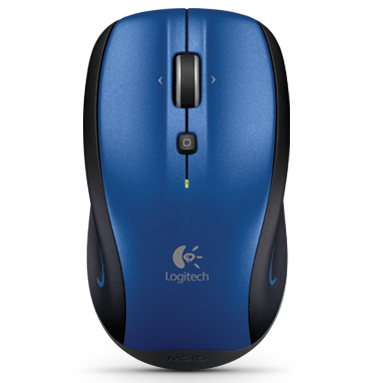|
Wireless Media Stick and "Couch Mouse" – Convenience Incarnate?By Jim Bray Looking for a way to stream media files from a computer to a media player? If so, you might want to check out HSTi's Wireless Media Stick – though you should also prepare for some frustration. Likewise, Logitech's "Couch Mouse" M515 is a handy little gadget designed to let you point and/or click even when you're doing it on a rough fabric surface. Let's look at the Wireless Media Stick first. I saw this product demonstrated at the Consumer Electronics Show back in January and the concept really appealed to me. It's basically a USB stick that looks like a largish "thumb drive" but which is used to stream media files wirelessly from a networked computer or Android Smartphone/Tablet to a USB port-equipped media player, without requiring the media player to have Wi-Fi, or even a network connection, of its own. The company bills it as a simple way to share your video, music or photo files on any computer, supposedly merely by activating the Wireless Media Stick on your wireless network and plugging the Stick into the USB port of the media player you're using. The Stick finds the shared media files on your networked computers and they show up on your media player as if stored locally. Choose a file to play and the Stick streams it, rather than copying or moving the files from their original location. Sounds great, doesn't it? What the $119 Wireless Media Stick is then, basically, is a network bridge between your computer and your media player which the company says, could be your TV, DVD or Blu-ray player, game console, stereo, digital picture frame, etc. Since the Wireless Media Stick streams the files, there's no need to store them on the Stick itself, which means the stick itself doesn't need a huge memory capacity, though the company says it has a "virtual terabyte" of storage anyway. HSTi says the Stick is easy to set up, via a three step process: 1. Connect the Wireless Media Stick to the your wireless network It sounds simple. File sharing is already part of your computer's capabilities and thanks to that, there's no extra software to install to use the Wireless Media Stick and share files from your Mac, PC or Linux computer, NAS device or Android Smartphone/Tablet. Both my son and I loved the concept and were dying to try it. It appealed to me because I like to stream media files (music, mostly) and my media player doesn't have Wi-Fi capability – a really dumb oversight on the part of the manufacturer but a nice "in" for the HSTi folk. My son liked the idea because he wanted to stream photos to his non-Wi-Fi-equipped photo frame. I work in the Windows environment and he's a "Mac-ite," so between us it was a pretty decent test of the Stick's performance and capabilities. So does it work as advertised? Yes. And no. I found the setup to be very slow and tedious. Stick the Stick into a USB port of your computer and eventually the install wizard shows up and then it walks you through the process. Don't forget to share the folders you want it to access, though, or you're wasting your time (this isn't a shot at the stick, just a reminder!). In use, the Stick is also very slow to do its things and we noticed that it would disconnect periodically from the computer and/or device, as in the "drive" disappears from your list. I'd have to unplug it, replug it and start over again more than once. That was quite frustrating. It also takes seemingly forever to "load files" and is also slow during the transfer/read process. This could be due in part to the performance of our networks though, depending upon where in the house we used them, the networks seem to work fine with other things. The Stick is also slow to load new directories when you're switching to them, which makes browsing a tad tedious. This could be a network speed issue as well, but I don't think so: my media player, when I network it, is faster than the Stick. After a long boot process, the Stick shows up as two disks (one holds the setup program, the other is the shared media). My son's photo frames didn't seem to like that and never did show the media drive, making much of the exercise moot. And some directories don't load at all, though we could never figure out why. Security issues on files? Possibly, but he was using wide open "media" folders that should have showed up on the Stick, but didn't. There's also no log on control, if you have security on your files or shares, so absolutely everything on the share has to be readable publicly, which may not be the way you want to operate, especially if you're in a wireless environment. Still, we really like the idea, not only because of the concept itself, but because we share a home town with the HSTi folk and because of that have a soft spot in our hearts for them and wish them well as they take on the world. Hopefully, subsequent generations will address the issues we noticed. But as it stands, this is an idea whose time has come but whose execution leaves something to be desired. On the other hand, it appears not everyone agrees with us: Android Central named the Wireless Media Stick the Best Android Accessory of CES 2011, though it doesn't appear as if they actually tested it at the time they were doling out their CES laurels. That reminds me: there's an Android app for the Stick that lets you use your smart phone or tablet as the source for your media files. I haven't tried it, though. HSTi also makes adaptations of the Wireless Media Stick designed to make it more flexible, including the "StreamStick," which lets you exploit video on demand, and the Wireless Media Stick for Digital Signage. 
A Better Mouse? Logitech's Couch Mouse M515, on the other hand, does work exactly as advertised. Its raison d'etre is to let you point at stuff on your screen even if you're on the couch, in bed or – as happens sometimes when my wife gets upset at me – when you're on the carpet. It works great on my desktop PC, too. The cute little $50 rodent is smaller than the mouse I use normally with my desktop PC, which is a good thing because it fits nicely under my hand (in a kind of "underhanded" way, I daresay). Its bottom is smoother than a baby's, to help keep lint, fabric fuzz, pet hair, and all that other disgusting stuff that can clog a mouse, at bay. That helps it glide better on surfaces where some other rodent pointing devices can snag. It works fine, though I wish I could have configured the wheel to act as a third button, if pressed, rather than having an actual third button just behind it, where you have to think about it and actually reach for it. Not a big deal, though, and I'm already used to it. I just don't adapt to change well… You can configure the Couch Mouse to let you scroll quickly up and down, which is nice if you're navigating long web pages, and a "click to click" mode lets you step through photo albums, etc. And get this: the mouse includes Hand Detection, so it works only when you’re holding it and goes to sleep otherwise. This should help make your batteries last longer. That's a good thing; my review sample's batteries were dead when I unpacked the Couch Mouse, so hopefully the ones I had to put in myself will last the two years Logitech says they should. The M515 Couch Mouse also uses Logitech's diminutive "Unifying receiver" that can work with other wireless devices, kind of like you can pair different Bluetooth phones or audio players to one device. The Couch Mouse doesn't come with any software, but you can download it from Logitech's site and use it to customize its configuration. A better mouse, er, trap? Probably not, but a nice solution for "couch" potatoes. Copyright 2011 Jim Bray Jim Bray's columns are available through the TechnoFile Syndicate. We welcome your comments! |
|
|||||
